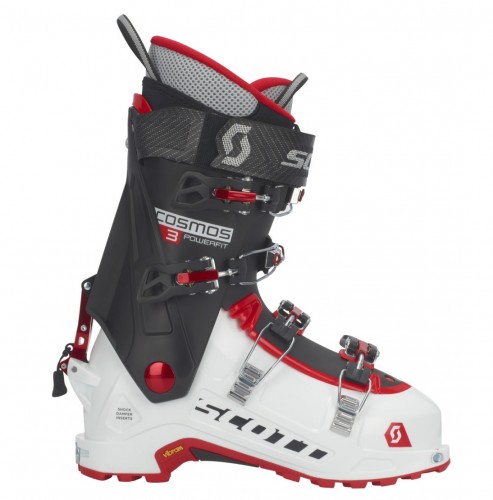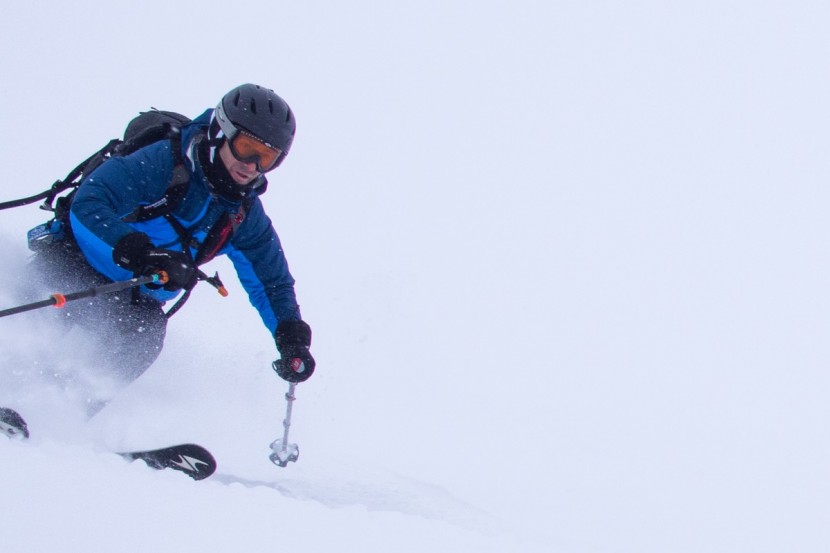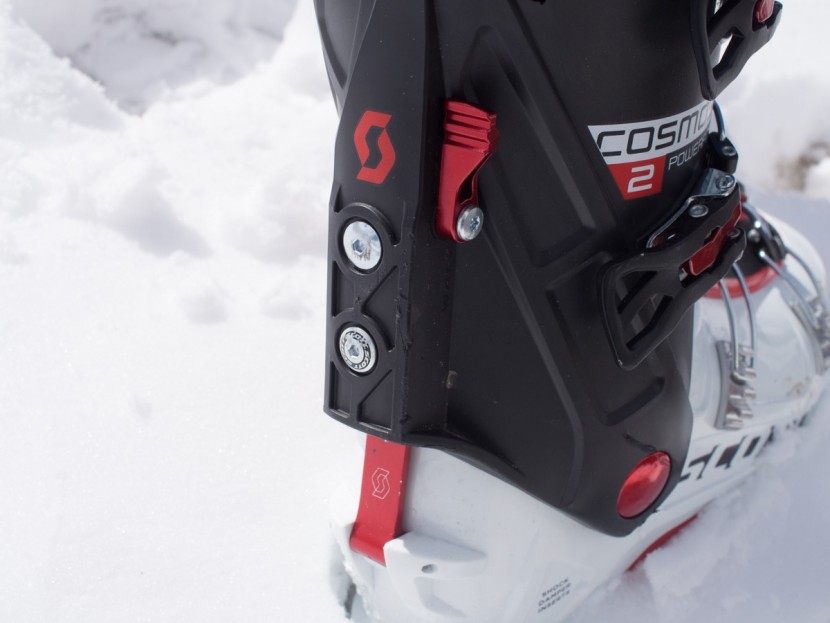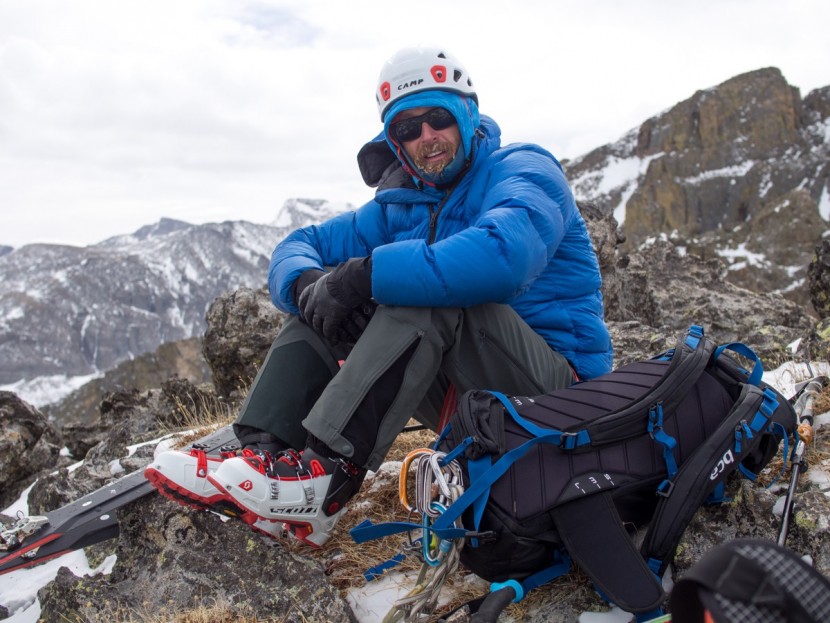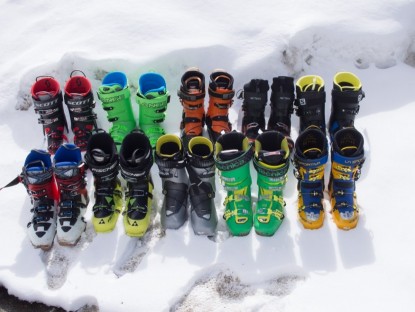Scott has released the updated version of this boot, the Cosmos III. Read on below to see what's been updated!
Scott Cosmos III Review
Our Verdict
Scott has released the updated version of this boot, the Cosmos III. Read on below to see what's been updated!
Our Analysis and Test Results
The New Scott Cosmos III vs. the Old Cosmos II
Scott has updated this boot with a new, fully external walk mechanism. The folks at Scott informed us that this new walk mechanism is more reliable than the old one and, being fully external, is easier for the average Joe to work on should something go wrong with it. The look of the boot remains almost exactly the same. See the comparison photos below, with the new Cosmos III on the left and the old Cosmos II on the right.
- Updated Walk Mechanism — Scott has updated the ski/walk mechanism to be fully external on the Cosmos III. They claim that this new Rear Hook mechanism (seen on the boot on the left, above) is more durable and reliable and has less chance to develop play, creating a more precise boot.
We haven't had a chance to check out the Cosmos III yet, so the rest of this review is based on our experience with the Cosmos II.
Hands-On Review of the Cosmos II
The Scott Cosmos II is a classic, if a bit dated design. The four buckle, tongue-constructed ski touring boot has been available, largely unchanged in major form, for over 20 years. This pair of backcountry ski boots is a product of evolution, bringing refinement and modern function to this familiar form factor. Other, more innovative designs surpass the Cosmos, but those with traditional preferences and a distaste for experimenting will find familiar attributes in the Cosmos II.
Uphill Performance
When evaluating uphill performance, we are primarily assessing the resistance to fore and aft ankle mobility and the distance of that mobility. Each boot has a maximum range of mobility, and then a measure of resistance in that range. The Cosmos has below average mobility and above average resistance. The clever design attributes of something like the Dynafit TLT 7 or the Atomic Backland Carbon lend a much greater range of motion. Similarly, there are design cues that other companies employ to reduce the friction and inhibition within this range. The cuff pivots of the Cosmos are stiff, while the “traditional” bar and pin ski/walk mode adds friction. In short, the touring mode of the Cosmos isn't anything special. It is similar, overall, to that of the Salomon S/Lab MTN and the Best Buy Dynafit Radical and only slightly better than the uphill performance of the Top Pick Lange XT FreeTour 130.
Weight
Outside of the specialty “ultra light” class boots we reviewed, like the Dynafit TLT 7, Atomic Backland Carbon, and Arc'teryx Procline Carbon Lite, the Cosmos II is the lightest in our test. It even surpasses, at least in this size, the weight of the La Sportiva Spectre 2.0. At one time, La Sportiva claimed that their Spectre was the “lightest 4-buckle AT ski boot” on the market. Not any longer, as the Cosmos has surpassed that, with better downhill performance and more comfortable fit.
Downhill Performance
The downhill performance of our tested boots varies considerably. Generally, that performance is correlated with weight. Heavier boots ski better. In this case, the Cosmos defies this generalization, at least a little bit. For one thing, our test team unanimously found it to ski better than the slightly heavier La Sportiva Spectre 2.0. The Cosmos, with excellent lateral stiffness and a forward flex pattern that is more “progressive” (and therefore better performing) than anything but the overlap constructed Top Pick Lange XT FreeTour 130 or the Tecnica Zero G Guide, and the unique Editors' Choice Atomic Hawx. The Cosmos II skis way better than the Arc'teryx Procline Carbon Lite. The Arc'teryx is only a half pound (per pair) lighter than the Cosmos. The Salomon S/Lab MTN and the Fischer Transalp Vacuum TS ski better overall than the Cosmos, but all are heavier too.
Comfort and Fit
Only a few boots in our test yielded no complaints when used “out of the box”. The TLT 7, the Radical, the Lange XT, the Fischer Transalp, and the Scott Cosmos all share this admirable attribute, at least for our lead test editor with fairly neutrally sized and rather tolerant feet. For this reason, we grant the Cosmos fairly high comfort scores.
The fit of the Cosmos can be described as medium in volume. If there is anything notable about the fit, it is that the toe box is more close fitting than the rest of the boots. This is a legacy borrowed from Garmont AT boots. Garmont AT boots were a staple of the touring business through the 2000's and early two-thousand teens, until Scott bought the molds. It is no wonder that the Cosmos fits like an old Garmont boot.
Warmth
For a boot this light, it is remarkably warm. In an insanely windy and cold ski mountaineering day in Rocky Mountain National Park, our lead test editor (who has generally cold feet) had no problems in the Cosmos. The warmth comes from a thick and foamy liner. We only hope that this liner doesn't pack out. In comparison, the similar weight-class La Sportiva Spectre has a much thinner liner, yielding less insulating value. The ultralight boots are much colder, while the beefy Lange XT is more insulating.
Ease of Use
We've grown somewhat accustomed to the speedy race style transitions accessible in the lighter touring boots like the Dynafit TLT 7 and its precursors and close competitors. As compared to these, which can require only one step to go between ski and tour mode, having to tighten two cuff buckles, a power strap, and flip the ski/walk mode lever seems cumbersome. Thankfully all the hardware is durable and clean, but there are simply more steps with this traditional four buckle design.
In our first day of using the Cosmos II we had a fairly unique, though short-lived problem. While touring, for occasional and random steps, the boots would lock into ski mode and then unlock themselves. After that first day, we had no such problem again. Presumably something “broke in” that first day and the equipment worked as designed through the remainder of our test.
Best Applications
This is an excellent all-around ski touring boot for someone apprehensive about the specialized designs of something like the Dynafit TLT 7. For newer backcountry converts, the Cosmos offers an ease of transition, with a form-factor that appears and functions more similar to one's regular alpine boots, with touring and climbing performance that approaches that of the lighter products.
Value
The Cosmos II falls right in the middle of the price spectrum of boots we tested. Certainly, the Best Buy Dynafit Radical Boot is a better value, with a lower price and performance that approaches that of the Cosmos. At the other end of the price spectrum, the specialized and more carefully engineered Editors' Choice and the super niche product Arc'teryx Procline Carbon Lite can be found. For the cost, the Cosmos II seems like a good product.
Conclusion
The Cosmos excels for all-around ski touring and ski mountaineering. It isn't flashy in any one category, but it delivers solid performance. Some updated design considerations could eliminate some weight and enhance the touring function, but we wouldn't want to see those compromises reduce the ski performance or comfort.


